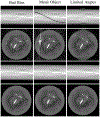Autoregression and Structured Low-Rank Modeling of Sinogram Neighborhoods
- PMID: 35059472
- PMCID: PMC8769528
- DOI: 10.1109/tci.2021.3114994
Autoregression and Structured Low-Rank Modeling of Sinogram Neighborhoods
Abstract
Sinograms are commonly used to represent the raw data from tomographic imaging experiments. Although it is already well-known that sinograms posess some amount of redundancy, in this work, we present novel theory suggesting that sinograms will often possess substantial additional redundancies that have not been explicitly exploited by previous methods. Specifically, we derive that sinograms will often satisfy multiple simple data-dependent autoregression relationships. This kind of autoregressive structure enables missing/degraded sinogram samples to be linearly predicted using a simple shift-invariant linear combination of neighboring samples. Our theory also further implies that if sinogram samples are assembled into a structured Hankel/Toeplitz matrix, then the matrix will be expected to have low-rank characteristics. As a result, sinogram restoration problems can be formulated as structured low-rank matrix recovery problems. Illustrations of this approach are provided using several different (real and simulated) X-ray imaging datasets, including comparisons against a state-of-the-art deep learning approach. Results suggest that structured low-rank matrix methods for sinogram recovery can have comparable performance to state-of-the-art approaches. Although our evaluation focuses on competitive comparisons against other approaches, we believe that autoregressive constraints are actually complementary to existing approaches with strong potential synergies.
Keywords: Autoregression; Sinogram restoration; Structured low-rank matrix recovery; Tomographic imaging.
Figures









References
-
- Natterer F, The Mathematics of Computerized Tomography. Philadelphia: SIAM, 2001.
-
- Clackdoyle R and Defrise M, “Tomographic reconstruction in the 21st century,” IEEE Signal Process. Mag, vol. 27, pp. 60–80, 2010.
-
- Ludwig D, “The Radon transform on Euclidean space,” Comm. Pure Appl. Math, vol. 19, pp. 49–81, 1966.
-
- Karp J, Muehllehner G, and Lewitt R, “Constrained Fourier space method for compensation of missing data in emission computed tomography,” IEEE Trans. Med. Imag, vol. 7, pp. 21–25, 1988. - PubMed
Grants and funding
LinkOut - more resources
Full Text Sources
Research Materials
